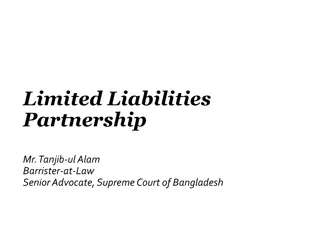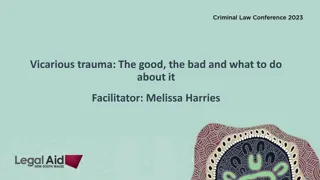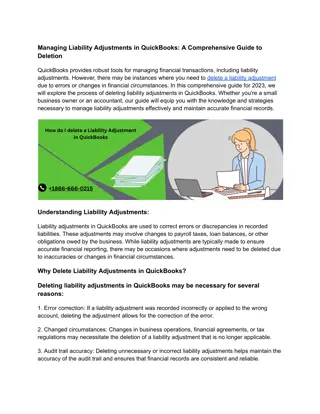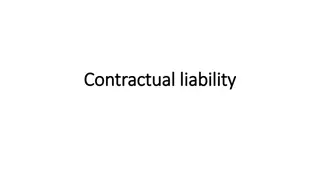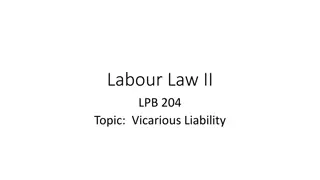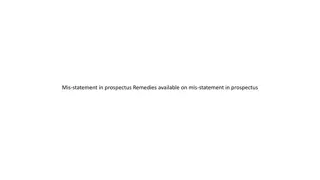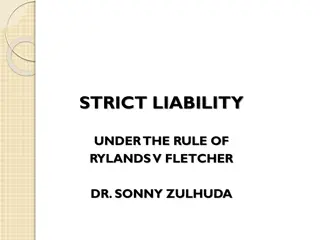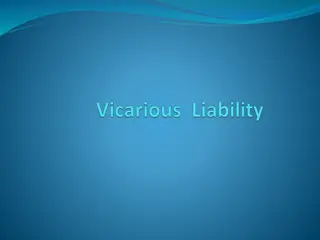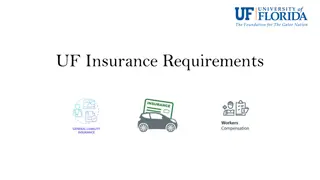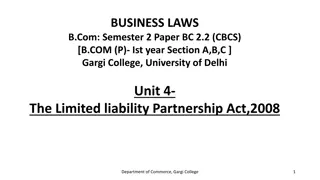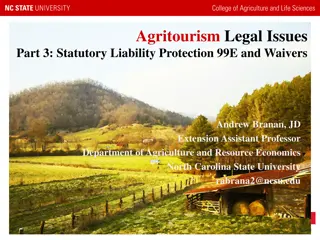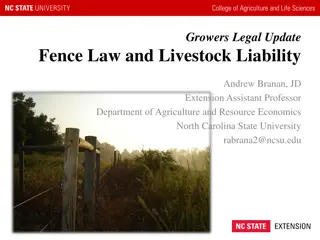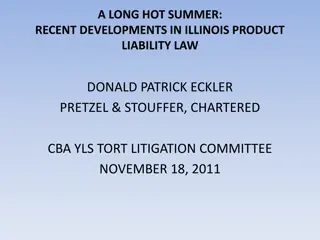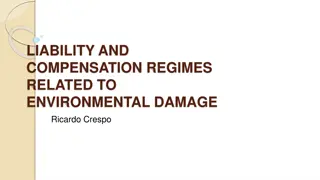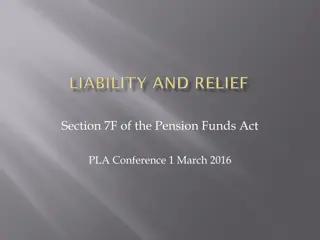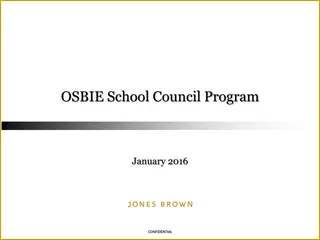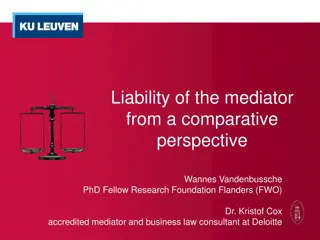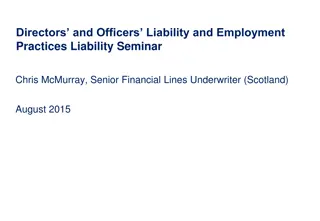Vicarious Liability
Vicarious liability refers to one person's responsibility for another's torts, often seen in employer-employee relationships. Learn about tests for employee status and employer liability for employee acts in this informative content.
Download Presentation

Please find below an Image/Link to download the presentation.
The content on the website is provided AS IS for your information and personal use only. It may not be sold, licensed, or shared on other websites without obtaining consent from the author.If you encounter any issues during the download, it is possible that the publisher has removed the file from their server.
You are allowed to download the files provided on this website for personal or commercial use, subject to the condition that they are used lawfully. All files are the property of their respective owners.
The content on the website is provided AS IS for your information and personal use only. It may not be sold, licensed, or shared on other websites without obtaining consent from the author.
E N D
Presentation Transcript
Learning Objectives By the end of the session you should be able to: Define vicarious liability Explain the tests for employee status Explain the liability of an employer for the torts of employees on a frolic of their own Explain the liability of an employer for the torts of employees doing an authorised act in an unauthorised manner Explain the liability of an employer for the torts of employees doing a criminal act 1. 2. 3. 4. 5.
The Meaning of Vicarious Liability Vicarious liability is the term used to explain the liability of one person for the torts committed by another. It mostly arises in employment when an employer might be liable for the torts of his employee.
Who is an Employee? How would you define the word employee ?
Who is an Employee? The courts have established a number of different tests to establish if a person is an employee or not: The control test The organisation test The economic reality test
The Control Test The test was established in Yewen v Noakes [1880]. It considers whether the employer has the power to control the nature of work done and how it is done. It is an old test that uses the concept of the master-servant relationship.
Organisation Test This test relies on a distinction between a contract of service and a contract for service. In Stevenson, Jordan & Harrison Ltd v MacDonald & Evans [1952], Lord Denning stated: One feature which seems to run through the instances is that, under a contract of service, a man is employed as part of the business, and his work is done as an integral part of the business; whereas, under a contract for services, his work, although done for the business, is not integrated into it but is only accessory to it.
Economic Reality Test In Ready Mixed Concrete (South East) Ltd v Minister of Pensions and National Insurance [1967] the High Court held that a contract of service exists if: The servant agrees that, in consideration of a wage or other remuneration, he will provide his own work and skill in the performance of some service for his master. 1. He agrees, expressly or impliedly, that in the performance of that service he will be subject to the other's control in a sufficient degree to make that other master. 2. The other provisions of the contract are consistent with its being a contract of service. 3. http://www.bailii.org/cgi- bin/format.cgi?doc=/ew/cases/EWHC/QB/1967/3.html&query=(ready)+AND+(mixed)+AND+(con crete)
The other provisions of the contract are consistent with its being a contract of service. The third condition in Ready Mixed Concrete (South East) Ltd v Minister of Pensions and National Insurance [1967] covers issues such as: The method of payments Responsibility for deducting the tax and national insurance contributions The working hours The level of independence of the employee/contractor The relative responsibility for providing equipment.
The Course of Employment An employer is not responsible for a tort committed by an employee outside of the course employment. An employer may be responsible for a tort committed by an employee during the course of employment.
A Frolic of his Own An employer is not liable for the torts committed by an employee who is on a frolic of his own. This means that if an employee does something not related to his work and is undertaken on his own count, then the employer will not be liable for a tort committed during the frolic .
Storey v Ashton [1869]: A Frolic of his Own Facts: The defendant sent two employee in a horse and cart to deliver some wine. On the way back the two employees went on a diversion in order to do some business of their own. While doing this the claimant was run over, owing to the negligence of the employee driving the horse and cart. Held: The defendant was not liable for the negligence of his employee because he was on a frolic of his own.
An Authorised Act An employer is vicariously liable for the torts of his employee if the employee is doing an act authorised by the employer in the authorised manner.
An Authorised Act in an Unauthorised Manner The general rule is that an employer is vicariously liable for an authorised act done in an unauthorised manner. However, the employer is not responsible if the employee is acting beyond the scope of his or her employment.
An Authorised Act in an Unauthorised Manner Please use a textbook or multi media device to research the following two contrasting cases: Century Insurance v Northern Ireland Transport Board [1942] http://www.bailii.org/cgi- bin/format.cgi?doc=/uk/cases/UKHL/1942/2.html&query=(Century)+AND+(Insurance) +AND+(v)+AND+(Northern)+AND+(Ireland)+AND+(Transport)+AND+(Board)+AND+([1 942]) And Iqbal v London Transport Executive [1973] http://www.bailii.org/cgi- bin/format.cgi?doc=/ew/cases/EWCA/Civ/1973/3.html&query=(Beard)+AND+(v)+AN D+(London)+AND+(Omnibus)+AND+(Co)+AND+([1900])
An Authorised Act in an Unauthorised Manner Why was the employer held to be vicariously liable in Century Insurance but not in Iqbal?
An Authorised Act in an Unauthorised Manner Why was the employer held to be vicariously liable in Century Insurance but not in Iqbal? Answer: In Century Insurance, the employee was acting in the course of his employment (i.e. delivering petrol in a tanker) albeit in a negligent manner. However, in Iqbal, the employee was acting outside of the scope of his employment (i.e. he was not employed as a driver) and there was an express prohibition forbidding him from driving a bus.
An Unlawful Act of an Employee An employer will only be held to be vicariously liable for the unlawful acts of his/her employee if there is a closeness of connection between the employment and the unlawful act. For instance, if a store security guard uses unreasonable and excessive force in stopping a shoplifter then it is likely that his/her employer will be held to be vicariously liable. There is a closeness of connection between the employment and the unlawful act. However, if the store detective punches a customer because she believes she is having an affair with her husband, then it is unlikely the employer will be vicariously liable. There is no closeness of connection between the employment and the unlawful act.
Lister and Others v Helsey Hall Ltd [2002] Facts: The claimants were residential students at a school for difficult children owned by the defendant. On of the wardens employed at the school had sexually abused a number of the children. The claimants argued that the owner of the school was vicariously liable for the harm they suffered as a result of the abuse. Held: The House of Lords held that the owner of the school was vicariously liable. They used a closeness of connection test to determine the vicarious liability.
Lister and Others v Helsey Hall Ltd [2002] Lord Steyn: I am satisfied that the evidence showed that the employers entrusted the care of the children to the warden. The question is whether the warden's torts were so closely connected with his employment that it would be fair and just to hold the employers vicariously liable. On the facts of the case the answer is yes. After all, the sexual abuse was inextricably interwoven with the carrying out by the warden of his duties... Matters of degree arise. But the present cases clearly fall on the side of vicarious liability. https://www.publications.parliament.uk/pa/ld200001/ldjudgmt/jd01 0503/lister-1.htm
Catholic Child Welfare Society v Institute of the Brothers of the Christian Schools (2012) The decision in Lister was developed further in Catholic Child Welfare Society v Institute of the Brothers of the Christian Schools (2012) were the Supreme Court held that You can read the full decision here: https://www.supremecourt.uk/cases/docs/uksc-2010-0230- judgment.pdf You can watch a summary of the judgement read by Lady Hale in the Supreme Court here: https://www.youtube.com/watch?v=f_xq9WyT2HY
Gravil v Carroll & Redruth Rugby Club [2008] Facts: Both the claimant and the defendant were semi-professional rugby players. The defendant punched the claimant during a rugby match in an off-the- ball assault causing a fracture of the right orbit. The clamant brought an action against both the defendant and the rugby club that the defendant played for. Held: the Court of Appeal held that rugby club was vicariously liable for the tort committed by their employee. [Carroll took no part in the appeal and had already been held liable by the trial judge for trespass to the person.]
Gravil v Carroll & Redruth Rugby Club [2008] Clarke MR: We answer the question whether the tort was so closely connected with the employment, namely the playing of rugby for the club, that it would be fair and just to hold the club vicariously responsible for the injury to the claimant in the affirmative. The punch is fairly and properly regarded as having been carried out while the first defendant was acting in the ordinary course of his employment, albeit part time employment, as a rugby player. Looking at the matter broadly, it is fair and just to hold the club liable for the punch in circumstances in which it can fairly be regarded as a reasonably incidental risk to the playing of rugby pursuant to the contract. http://www.bailii.org/ew/cases/EWCA/Civ/2008/689.html
Activity Use a textbook or multimedia device to find out the facts and decisions in the following two cases: Majrowski (Respondent) v Guy's and St. Thomas' NHS Trust (Appellants) [2006] https://www.publications.parliament.uk/pa/ld200506/ldjudgmt/jd060 712/majro-1.htm Maga v Trustees of the Birmingham Archdiocese of the Roman Catholic Church [2010] http://www.bailii.org/ew/cases/EWCA/Civ/2010/256.html
Liability for the Torts of Independent Contractors A person or company may in some circumstances be held liable for the torts committed by an independent contractor to visitors and non visitors. Please see the presentations on occupiers liability.





